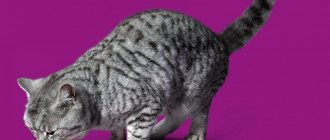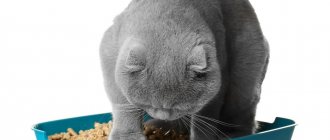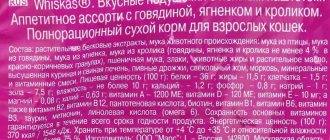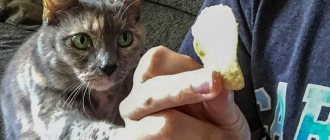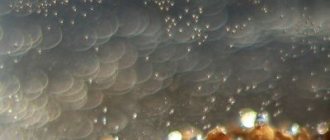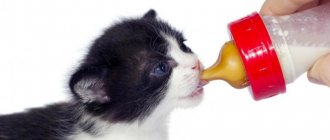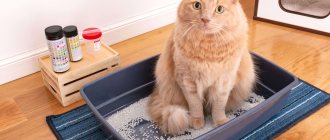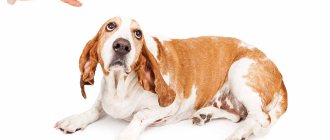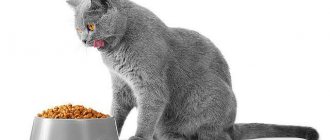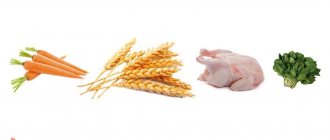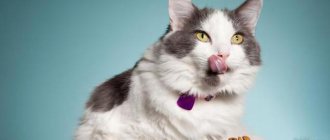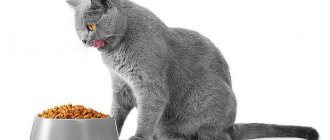Most owners, when choosing food that is better and more suitable for their pet, pay attention to the brand, advertising and reviews. Friskies and Whiskas are considered very popular, the most common, as they are advertised. This or that brand is the buyer’s choice, but it is recommended to focus on the consequences and the desire with which the pet eats the food. What is better than “Friskies” or “Whiskas” and what to feed your pet will help you find out information about the composition.
How Kitekat food affects your pet's body
It is believed that cheap food can do nothing but harm to a cat. This is explained by the characteristics of the composition:
- Products processed from animal components (bone meal, feathers, hooves, beaks, etc.) may be of too low quality.
- Dyes, preservatives and other artificial ingredients poison the body.
- Corn and yeast can cause allergies.
- The food contains flavorings and taste enhancers, which means that the cat can get used to the food.
Many cat owners who fed their pets “Kitiket” attribute all their “sins” to this food when the animal gets sick. Veterinarians strongly recommend feeding their patients exclusively high-grade food. But this question can be looked at from the other side:
- Cheap ingredients (offal) are normal food for cats. In the wild, they feed on mice, birds, etc. Such components are valuable for the presence of protein.
- Dyes are also found in some expensive foods, and all food dyes are allowed by different standards. And preservatives are absolutely necessary to ensure that the food does not spoil.
- Allergens are sometimes found in holistic foods. The characteristics of the composition are determined by the manufacturer himself, especially since not all cats have allergies.
- Flavorings are needed not to cause addiction, but to give the animal an appetite, because it affects digestion.
I often hear from cat owners phrases like “Kitiket is poison”, “It’s all chemicals”, “They add drugs to this food”, etc. I think this is all exaggerated. Buying cat food is similar to choosing human food. For example, if a person does not have money for a piece of fresh boneless beef, then he will buy inexpensive sausages or sausage. Sausages, for example, also contain dyes, flavors, preservatives and the same by-products. People understand that it is not very useful, but they still buy it. So does cat food. Everyone buys food within their budget.
Despite a large number of angry reviews, cat owners continue to buy these products
If economy class food is produced and it is permitted by law, it means that it does not have to be harmful to health. But you need to remember to follow the feeding rules:
- You cannot mix natural food and ready-made food (as well as food of different brands). Each food is balanced in its own way, and when mixed, this balance is disrupted. For example, you cannot feed your cat “Kitiket” and raw fish - this leads to severe attacks of urolithiasis.
- If we are talking about dry food, then you need to take a more serious approach to the drinking regime (there should be plenty of water, otherwise it will have a bad effect on digestion and kidney function).
- There is no need to “stuff” your cat with vitamins and various supplements without the recommendation of a veterinarian (this also upsets the balance).
- You need to carefully follow the manufacturer's recommendations (volume and number of feedings) so that your pet does not have to be fed with natural food.
- Nursing and pregnant cats need to be fed more often to prevent them from starving.
When is it contraindicated to give them to a cat?
There are animals that are not recommended to be fed with such food:
- cats with urolithiasis or kidney failure;
- kittens under 1 year of age (they need a differently balanced diet);
- cats and cats prone to allergies.
My sister's cat has urolithiasis. For two years he ate mainly fish, which led to the development of the disease (according to the veterinarian, fish is one of the provoking foods, as it contains a lot of phosphorus). The veterinarian prescribed treatment and recommended switching the cat to complete industrial food. My sister bought Kitiket, but experts advised replacing the food with a veterinary diet (super premium food).
Kitekat food is contraindicated for kittens, allergic cats and animals with urolithiasis
Canned Frisks
Advantages:
- ready-made, balanced food that can be given to your cat daily (either on its own or in combination with dry food of the same brand);
- suitable for feeding kittens and adult animals;
- wet food causes a greater appetite than dry food; it does not have to be washed down with water;
- a wide range of;
- easy to find on sale.
Flaws:
- According to veterinarians, opened canned food at room temperature cannot be stored for more than 2 hours;
- the price is higher than that of dry food;
- belonging to economy class.
Useful information: shiny fur, good, playful mood, painless and timely defecation, absence of strong unpleasant odors from the mouth and from the tray of your mustachioed pet - this is a sure sign that the food is suitable for him. If you have any doubts, reconsider your view on the nutrition of a kitten at 4 months or consult a specialist.
It will be interesting:
- Hill's food reviews;
- Royal Canin cat food reviews;
- Acana cat food reviews;
- veterinarian reviews of Proplan for cats.
Ingredients of Whiskas: what is included?
Whiskas dry food is one of the well-known budget types of cat food. The country of origin is the USA, the Mars Corporation, which owns the brands Kitiket, Royal Canin, and Sheba. Whiskas products can be purchased in supermarkets or pet stores. The pack contains 350 and 800 g. Large packages are sold in 1.9 and 5 kg. The ingredients are indicated on the box, but the manufacturers do not specify the exact percentage of ingredients, and the presence of dyes and preservatives is not stated at all. It does not say which by-products are added to the feed. Accurate information can only be found on the website of the American manufacturer of dry food for cats. Composition of Whiskas feed:
- wheat flour;
- cereals;
- animal meal from poultry meat and bones;
- rice;
- plant protein extracts;
- offal;
- animal fat;
- sunflower oil;
- Brewer's yeast;
- vegetable pulp, mainly carrots and beets;
- vitamins and minerals;
- taurine
Brand history
Whiskas was the first animal food product to be commercialized by the American company Mars. This happened in 1932, and now in terms of sales it is in first place among industrial diets for cats in the world. Divisions of this company are located all over the world, but the main representative office of Mars Petcare is located in Belgium, in Brussels. In 1991, the company began operating in Russia, and already in 1995, the first plant for the production of food for pets opened in Stupino. At the moment, there are already several feed production factories in the Russian Federation.
The pride of the company is the Waltham research and development center, located in the UK. Leading experts in the field of veterinary medicine and pet nutrition are developing new concepts that are used in ready-made food formulas for cats. One of the most famous achievements of this laboratory is the recognition of the important role of taurine in the body of cats.
Cats are not able to produce this substance on their own and can only get it from food, so Whiskas was the first food to which it was added. This was a significant breakthrough in the field of ready-made diets for domestic cats. Currently, all complete feeds include taurine.
Alternative
From a physiological point of view, a natural diet based on meat and cereals is more useful. The intestines of a predator are adapted for processing hard protein foods; soft foods cause digestive disorders and lead to tooth damage. Proper natural feeding requires a lot of time and expense.
Most owners feed their pets with ready-made food. Their advantages:
- provide balanced nutrition;
- facilitate the calculation of the required calorie intake;
- have a long shelf life.
Dry food is divided according to quality into the following groups:
- Economy class - Friskies, Kitekat. Contains 5% protein, a large amount of starch, preservatives.
- Premium class - Royal Canin, Proplan, Brit Premium. Includes animal and plant proteins 30-40%, preservatives. The composition is clearly indicated on the packaging. Average price 600 rub. for 1.5 kg.
- Super premium class - Brit Care, Bozita. Proteins of animal origin at least 40%. Average price 900 rub. for 2 kg.
- Holistics - Acana, Applaws, Grandorf. Contains up to 90% quality meat and fats. Average price 1200 rub. for 2 kg.
Large packages are usually cheaper.
If it is impossible to buy quality food, natural food will be preferable to harmful crackers with an artificial taste.
Some cats, having become dependent on Whiskas, flatly refuse to eat other food. You need to wean your animal off harmful products gradually by adding high-quality food to the diet. Start with minimal amounts that are invisible to the pet, gradually reducing the proportion of Whiskas. In 2-3 months you can painlessly wean your cat off junk food.
The harmfulness of Whiskas for cats and kittens is undeniable. The gloomy joke of veterinarians that as long as economy-class food exists, they will not face unemployment is not at all funny. Pets cannot choose their own food. It is the owner's responsibility to provide a safe and nutritious diet.
What are the consequences
Feeding your pet with ready-made food is quite simple, quick and inexpensive. However, few owners think about the possible consequences of such a diet for their pet.
Veterinarians point to the following diseases and pathological conditions that develop in cats whose menu is based on Whiskas and other economy-class foods:
- gastritis;
- ulcerative lesions of the gastrointestinal tract;
- bouts of vomiting;
- liver pathologies;
- development of dependence on food, refusal of other foods;
- kidney diseases;
- sand and stone formations localized in the kidney area;
- hair loss;
- skin, dermatological diseases;
- lethargy, passivity;
- development of obesity;
- the appearance of dandruff and skin rashes;
- pancreatitis.
Clinical studies have shown that cats fed Whiskas require more water. Thus, when eating 100 g of food, an animal must consume at least 250 ml of liquid, which is virtually unrealistic. Lack of proper drinking regime leads to serious problems with the kidneys and urination, increased urine concentration, and the formation of sand and stones.
If you constantly feed Whiskas to a small kitten, you can provoke delays in its development, a weakened immune system and an increased susceptibility to various kinds of diseases. Possible unwanted side effects include allergic reactions.
We suggest you read: How to treat a cat with poisoning
The results of the studies have proven that domestic cats that feed exclusively on Whiskas and often consume this food live on average no more than 5 years. At the same time, the average life expectancy of cats whose owners provide an optimally balanced menu is at least 10-15 years.
Scottish Straight: description of the breed
03/13/2018 1 review 89,
The Scottish Straight belongs to the category of popular shorthair cats. These are children of Scottish Fold cats, who, upon reaching the age of six months, remained straight-eared; recently they have become an independent breed. This division became necessary for the competent crossing of Scottish cats.
The homeland of these animals is Scotland. This breed was obtained by crossing with a Scottish fold cat. The lop-eared gene, which mutated hundreds of years ago, does not give all kittens curved ears; in some of them, the ears straighten after the first month of life, which forced them to be divided into Scottish Folds and Scottish Straights.
Feed composition
The composition of feed is varied and depends on both type and taste.
The pate includes the following components: at least ¼ - chicken, meat and offal, taurine, vitamins, minerals, vegetable oil.
Ingredients of jelly with veal or turkey:
- meat and offal, in particular veal/turkey, must make up at least 4%;
- vegetable oil;
- vitamins A, E;
- minerals;
- taurine
Whiskas for kittens (dry) “tasty pads” with turkey and carrots has the following food composition:
- wheat flour;
- animal meal (poultry meal, turkey meal);
- meat and bone meal;
- animal fats;
- protein plant extracts;
- vegetables;
- sunflower oil;
- Brewer's yeast;
- dairy products;
- vitamins;
- minerals;
- taurine
Scottish Straight cats
- much lighter, more graceful and more agile than the British
. The average weight of an adult male is 4−5 kg, and that of a cat is 3 kg; - round muzzle with large expressive eyes. The upper eyelid is almond-shaped. The ears are medium-sized, with rounded ends, but the ear cartilage is thinner than that of the British brothers;
- The body of these cats is of medium length, muscular, with a prominent chest. The paw bones are heavy, but the legs are slender. The tail is long and flexible;
- The color of the Scottish Straight is as varied as that of the British Shorthair breed. They also come in plain colors (white, blue, lilac, black) and in colors that combine several shades (including striped, temple-colored).
Pros and cons of Whiskas food
Whiskas for cats causes a lot of controversy among pet owners. Some are convinced that this is an excellent food and it is perfect for their pet, while others categorically urge you to refuse any product from this manufacturer, considering it harmful. But Whiskas is still in huge demand, so those considering this brand for their pet should know exactly all its advantages and disadvantages.
Advantages: favorite food at a low price
Advantages of Whiskas products:
- Affordable price. This is one of the most budget brands that everyone can afford. Feeding cats food from another manufacturer can cost several times more.
- Availability. Whiskas products are sold almost everywhere: from pet stores to regular supermarkets. If the food suddenly runs out, it will not be difficult for the owner of any breed to purchase it.
- Huge assortment. A variety of flavors will help you choose food for even the most picky cat. In addition, the brand has a line of special foods for sterilized and aged cats.
- Favorite pet food. Whiskas food always has an attractive appearance and smell. Cats really like it and they eat it with great appetite.
Food for a good appetite
Disadvantages: save on health
The disadvantages of Whiskas food include:
- Artificial additives. In the composition you can see preservatives, flavorings and many more different “E”. And the more additives there are in the recipe, the more harm they can cause to the health of the animal.
- Hidden composition. The manufacturer is either completely silent about many components or uses veiled concepts so as not to scare away the buyer. No one wants to buy food for their pet, the composition of which takes up a good half of the package and is replete with “chemicals”.
- Addiction. The additives contained in the composition are addictive to the animal. Because of this, the pet eats more than normal and may refuse other food altogether. Many owners have encountered this problem when they decide to replace Whiskas with another brand.
- Low quality. Offal and flour are not exactly what the animal’s body needs. Of course, even on this diet, many animals live a long time, without any health problems. But there is also a risk of disease. The ideal option would be holistic food, but not everyone can afford it.
Are there any differences between the products?
When choosing food for your pet, a person should pay attention to the proportion of meat in its composition.
The only difference is the price and the product is Hungarian, while Whiskas is Russian. If we rely on the rating, then “Friskies” is in 5th place, “Whiskas” is in 16th place. They are chosen only by their prevalence and they are considered the best in their category. If you can’t buy expensive food for your pet without ruining your cat’s health, you can find online ratings of the top 5 economy-class foods, which include Friskies and Whiskas. Also, veterinarians do not recommend mixing wet and dry feed. When comparing, it is worth considering that meat should only come first in the composition. At least 80% and without a huge number of additives. After all, a natural product contains only vitamins, minerals and beneficial substances.
No matter what, even the best economy food can be harmful. It is advisable to compare formulations, because both poor and high-quality products are sold at the same prices.
Can a kitten try different tastes?
When it comes to the Whiskas line of food, it’s not only possible, but even necessary. Animals also have their own tastes - why not find out from childhood what your pet prefers?
Perhaps he will be delighted with the most tender lamb stew? Or stick to the classic – delicious chicken stew? Or will he show his love for seafood and choose salmon? And how delighted he will be with jelly with turkey or diet rabbit! Or maybe the chicken pate will remain his favorite in the lineup.
One thing's for sure: Milk, Carrot and Turkey Crispy Puffs will become his favorite dry meal!
Should I give dry or wet food? Veterinarians recommend not choosing, but combining! It is advisable to select the proportion of each type of diet under the supervision of a specialist, but if you know that your baby rarely drinks water, it is better to focus on soft pieces in the jelly, their moisture content reaches up to 80%!
Canned Frisks
Advantages:
- ready-made, balanced food that can be given to your cat daily (either on its own or in combination with dry food of the same brand);
- suitable for feeding kittens and adult animals;
- wet food causes a greater appetite than dry food; it does not have to be washed down with water;
- a wide range of;
- easy to find on sale.
Flaws:
- According to veterinarians, opened canned food at room temperature cannot be stored for more than 2 hours;
- the price is higher than that of dry food;
- belonging to economy class.
Useful information: shiny fur, good, playful mood, painless and timely defecation, absence of strong unpleasant odors from the mouth and from the tray of your mustachioed pet - this is a sure sign that the food is suitable for him. If you have any doubts, reconsider your view on the nutrition of a kitten at 4 months or consult a specialist.
It will be interesting:
- Hill's food reviews;
- Royal Canin cat food reviews;
- Acana cat food reviews;
- veterinarian reviews of Proplan for cats.
Benefits and harms of economical food for cats
Fluffies are usually delighted with such food and gobble it up with pleasure.
The main advantage of Whiskas is its availability and low price per pack. It is very tasty for cats and they eat it with pleasure, quickly getting full. The owner does not need to spend time preparing food for the pet or developing its diet. Dry food lasts a long time. A wide range will allow you to choose a diet for pets with special needs.
Disputes about the dangers and benefits of Whiskas continue constantly. Doctors believe that these products cannot provide a pet with a balanced diet, since they consist of plant proteins and contain very little meat. In addition, the abundance of food additives and dyes harms the cat’s gastrointestinal tract. The American Veterinary Association has obtained information that the food is made from poor quality by-products, meat from the corpses of killed or euthanized animals, so there is no talk of benefits. After regularly consuming Whiskas in their pads, many cats develop urolithiasis. Liquid cat food in pouches is less harmful, but expensive. Pets quickly get used to the food and refuse natural food, and it is impossible to combine homemade food with factory-made food.
general information
“Friskies” food belongs to the economy class and is the lowest quality ready-made diet for animals. These products are produced by a division of Nestle - Purina. The corporation also owns the brands Felix, Purina One, Pro Plan, Gourmet, Darling and Cat Chow. The company specializes in the production of low-quality budget feed.
The logo is present on all products of this brand
The range and composition of Friskies food is reminiscent of the Whiskas line, its main competitor. The company produces a variety of wet ready-made diets with different flavors and flavoring additives, as well as granular products. There are no medicinal lines in the assortment, but there is food for animals with special needs.
Types of factory food
The owner can choose dry or wet food for his mustache.
The manufacturer made sure that each owner could choose a diet based on the taste of the pet. There is dry food in the form of pads and wet food. Feeds differ in their water content. The pads help keep your pet's teeth and gums healthy. You cannot mix two forms of the product during one meal.
Dry food
Most of the protein in dry food is of plant origin. These foods contain a small percentage of fiber and moisture. The wheat flour in the composition is poorly absorbed by pets, causing allergies. If the owner decides to feed the pet with pads, you need to make sure that the cat drinks a lot, and if necessary, water it yourself. According to reviews from veterinarians and cat owners, dry food is harmful to cats, causing damage to the urinary tract. The naturalness of the food is low, it contains flavoring additives, but this is not written on the pack. Cats love crispy “crinkles”, and ill-informed owners decide to continue buying pads, not suspecting that the consequences for the health of their pets will be sad. A bag of dry “Whiskas” or “Kiteket” should not be left open to air, and if the food has evaporated, it is better to take a new one.
Wet food
Wet food is available in the form of a pate.
Soft food is packaged in small packages - 100 gram pouches. Inside there are pieces of meat in jelly or sauce. Meat content is 4%, the rest is by-products. The composition is enriched with vitamin E, zinc, phosphorus, taurine. Wet food is easier to digest and does not require strict drinking regimen. An opened package should be stored in the refrigerator for no more than a day. Whiskas for kittens contains calcium, which is good for bones, and Omega-3 fatty acids for caring for the fur of little fluffies. Wet Whiskas in bags:
- cream soup;
- jelly;
- stew;
- pates.
Feeding standards
Until the kitten reaches 12 months of age, it should only be given kitten food. To determine the daily and single dose, you need to know the weight of the animal. The norms are calculated to cover all the nutritional needs of the cat, but Whiskas is not a complete food in composition, so the portions are larger than those of premium foods. With a mixed diet, dry and wet foods are divided into several meals. The box or packaging contains information about the amount of food calculated for the pet's weight. The norm can be adjusted based on the needs of the pet. When feeding dry food with meat or fish, you need to make sure that the amount of water you drink is three times the serving of pads. One-time standard factory food for the weight of an adult pet
| Cat weight, kg | Calories per day | Dry form, gram | Wet, gram |
| 2—3 | 170 | 45 | 200 |
| 4—5 | 250 | 55 | 250 |
| 5—8 | 300 | 65 | 300 |
